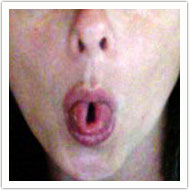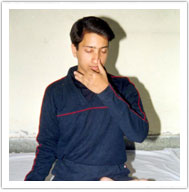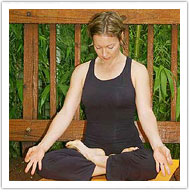| |
 |
| INTRODUCTION TO PRANAYAMA |
| |
PRANAYAMA – THE ART AND SCIENCE OF BREATHING |
Pranayama comes from Sanskrit word prana which means life force. Pranayama is a deliberate and conscious way of controlling your breath for pranayama. It is amazing to know that our lung pumps around 7 litres of air every minute. |
| |
Going back to thousands of years in past, the one of the major reasons for practice pranayama was encouraged in order to prolong the longevity of practitioner. According to the ancient texts of yoga, it was believed that the life span of living beings was determined by the number of breaths he/she takes in his/her whole life. |
|
|
| |
Some how, if we slow down the breathing process, then we may live longer was the initial idea of pranayama. Without trying to test and debate the validity of this particular belief, we will try to understand its benefits for the mass form the perspective of using it for gaining more vitality and better health. |
| |
| THE SCIENCE OR ART OF PRANAYAMA IS BASED ON 3 BASIC PROCESS OF BREATHING WHICH ARE |
| 1. Rechaka – Inhaling of breath |
| 2. Puraka - Exhaling of breath |
| 3. Kumbak – Stopping/Holding your breath |
| |
| PRANAYAMA OR BREATHING EXERCISE GENERALLY INVOLVES EITHER OR ALL OF THE BELOW METHOD OF BREATHING |
| |
| 1. Shallow and rapid Inhaling and exhaling breath |
| 2. Slow and deep Inhaling and exhaling of breath |
| 3. Stopping the breathing process completely |
| |
| BENEFITS OF PRACTICING PRANAYAMA |
| 1] |
Stronger Lungs : Increased activity in lung due to practicing of pranayama results in making the lungs more stronger and healthier. |
| |
|
| 2] |
Better Concentration Power : Increased supply of oxygen to brain makes it more active and receptive, and triggers alpha, or theta brain waves which may result in improved learning abilities. Sometime intense practice of pranayama may activate psychic centers or chakras in our subtle body. |
| |
|
| 3] |
Improved Relaxation Response : Deeper and slower breathing relaxes leads to mental, emotional and physical relaxation, which means pranayama is effective in stress management. |
| |
|
| 4] |
Peace of mind : Regular practice of pranayama lead to peace of mind or chittashanti. Please remember, peace of mind is the ultimate thing that we all crave for, and achieving this can done via practice of pranayama or breath control excercises. |
| |
|
| 5] |
Improved Quality of Sleep : Regular practice of pranayama can assist in curing sleeping disorders like insomnia. |
| |
|
| 6] |
Better Quality of Breathing : Many people have incorrect breathing pattern and this can be corrected, if pranayama can be practiced regularly. |
|
| |
Somebody has rightly quoted, that the secret of life in embedded in our breath, and if we learn to master our breathing we can control our thoughts and emotions and in turn our actions which make us fail or succeed in life. |
| |
| |
| EIGHT ARE FOUR TYPE OF PRANAYAMA: |
|
| |
| ANULOM VILOM |
| |
| METHOD TO CLOSE THE NOSTRILS: |
| |
To be done by closing the nostrils one after another, close the right nostril by the right hand thumb, and likewise close the left nostril by the 2nd and 3rd fingers (Madhyama and Anamika) fingers keep the palm of the hand in front just above the Nose. |
|
|
|
| METHOD: |
Prana breathed in through left nostril represents energy of the moon, which symbolizes peace, and has a cooling effect. Hence for purification of Nadis, beginning of this Pranayama has to be made by the left nostril. Close the right side nostril with the right hand thumb. Inhale slowly through the left nostril till the lungs are filled. Then close the left nostril with the second and third fingers. Open the right nostril and exhale through it. Repeat this exercise slowly in the beginning, and with practice, increase the speed. When you are able to practice this exercise for a long time, inhale with as much force as is possible for you, then exhale also forcefully. This practice of inhalation and exhalation alternatively through the right and left nostril, as indicated above with force, should be done for 3 minutes. If you feel tired, rest for sometimes and resume. Regular practice will enable you to do this Pranayama for 10 minutes. After some practice being established, this Pranayama should be done for 5 to 10 minutes daily, depending upon one’s capacity. However, in summer season it should be done for duration starting from 3 minutes and up to a maximum of 5 minutes. If you practice this Pranayama for five minutes regularly on a daily basis, the coiled energy called Kundalini Shakti lying in the Muladhar Chakra begins to awaken.This is known as Kundalini Jagran.. While doing this Pranayama, mentally repeat the mantra “OM” so the mind becomes fit for meditation. |
| |
| BENEFITS: |
|
Regular practice of this Pranayama has the capacity of cleansing all your innumerable Nadis, which makes the body healthy lustrous and strong.
|
| |
|
|
Blockages in the arteries of the heart are removed and the arteries become clean, making the circulation unimpeded. If this Pranayama is practiced for 3 or 4 months regularly, 30 to 40% of blockages in the arteries are dissolved and removed, preventing the phenomenon of heart attack. |
| |
|
|
Pathogenic cholesterol, triglycerides, H.D.L. and L.D.L. also get controlled, making the arterial channels clear for effective and unimpeded flow of blood in the heart. |
| |
|
|
Negative thinking is replaced by positive approach to life. It increases enthusiasm and spirit, the Sadhak becomes fearless and feels blissful. |
| |
|
|
In short, this Pranayama has the effect of cleansing the body, and the mind and cures almost all the diseases from which the Sadhaka has been suffering. If this Pranayama is practiced for 250 to 500 times a day, Kundalini Shakti turns its face upward and begin to rise above through the susumna Nadi. It means that the phenomenon known as Kundalini Jagran begins. |
|
|
| |
|
| BRAHMARI |
| |
Breathe in till your lungs are full of air. Close your ears with both the thumbs and eyes with the middle fingers of your hands on respective sides with little pressure. Press forehead with both the index fingers lightly. Close both the eyes. Then press eyes and nose bridge from the sides with the remaining fingers. Concentrate your mind on Ajna Chakra (between eye-brows) . Close your mouth. Begin slowly exhaling, making humming sound of a bee, while reciting “OM” mentally. Repeat the exercise 11 to 21 times according to your capacity. |
| |
| BENEFITS: |
With the practice of this Pranayama the mind becomes steady. It is beneficial in conditions like mental tension, agitation, high blood pressure, heart disease etc. It is also useful for meditation. |
| |
|
|
| |
| BHASTRIKA |
| |
Sit in a comfortable Asana. Breathe in through both the nostrils forcefully, till the lungs are full and diaphragm is stretched. Then breathe out forcefully also, but see that the abdominal cavity does not blow up due to the air breathed in. Depending upon the capacity and health of an individual, this Pranayama can be done in three variable speeds viz. slow speed, moderate speed and at high speed. Individuals with weak lungs and heart should do this at a slow speed while performing Recak and Puraka A healthy individual and one used to doing it, should do it initially at a slow speed and then gradually increase the speed to moderate and then high. This Pranayama should be done for 5 to 10 minutes. |
| |
|
|
|
| SPECIAL NOTES: |
 |
Those suffering from high blood pressure or from any heart disease should not do this Pranayama. |
| |
|
|
While breathing in the abdominal area should not blow up. You have to fill the air in the chest area, i.e. up to diaphragm, so that the part of the chest with its ribs swells. |
| |
|
|
In summer season, reduce the number of repititions of this Pranayama.
Incase both the nostrils do not open on account of ailments like severe cough or sinus etc., for such persons they should first close the right nostril and do respiration (exhalation as well as inhalation) through the left nostril. Then the left nostril should be closed and respiration should be done by the right nostril. This method of alternate breathing should be continued at the desired speed viz. slow, moderate or fast, till both the nostrils open simultaneously. Then at the end Pranayama should be completed by doing Recak and Pruaka through both Ida and Pingala. |
| |
|
|
One must do this Pranayama for the duration of three to five minutes every day.
While doing this Pranayama keep both the eyes closed and mentally chant the mantra “OM” throughout the exercise of Pranayama. |
| |
|
|
| BENEFITS: |
Diseases like cold, cough, allergy, asthma, respiratory diseases of all kinds, are cured. Lungs become strong and due to the heart and head getting adequate quantity of pure and fresh air, health is improved. |
| |
| DISEASES OF THE THROAT LIKE THYROID, TONSILS AND OTHER AILMENTS OF THROAT ARE CURED. |
| |
|
|
This Pranayama brings about a proper balance of the three Doshas i.e. Vata, Pitta, and Kapha, and maintains their balance. Blood is purified and the body gets rid of foreign objects and toxins. |
| |
|
|
Stabilizes Prana and calms mind, and helps the upward journey |
| |
|
|
Stabilizes Prana and calms mind and helps the upward journey of Prana from Muladhara Chakra (Base Chakra) to Sahsrar Chakra(Cerebral Gland) and helpful in the Kundalini Jagran. |
| |
| SURYA-BHEDANA (RIGHT-NOSTRIL BREATHING) |
|
| |
Surya means sun, referring to the right nostril which is the path of the Pingala Nadi. When you inhale solely through this nostril, heat is created in the body and the impurities that blocks the flow of Prana are dispelled. You may start your practice by repeating Surya Bhedana ten times and slowly build up a to forty. |
| |
| SURYA-BHEDANA |
This refers to the Breathing Exercise in which you inhale through the right nostril and exhale through the left, holding the inhaled breath as long as possible before exhaling. Beginners should expect to use their fingers in order to close either nostril, though you may eventually develop an ability to do this without using the fingers. You may close your nostrils in any way you choose to; but the traditional technique which has been the standard practice is as follows: |
| |
 |
Press the index and middle finger of the right hand against the palm of that hand |
 |
Use the thumb to close the right nostril and the ring and little fingers to close the left nostril. |
 |
If your are left handed, you may reverse this procedure. |
 |
When both nostrils are open, the fingers rest on the bridge of the nose. |
|
| |
| SHITALI |
Shitali means cooling. It is a pranayama which cools whole the body so it is best done in hot weather or at the end of a vigorous yoga session. |
|
Sit in a comfortable cross-legged position in a well ventilated room free from any distractions. Keep the waist, back, neck and spine erect. |
 |
Take two or three deep inhales and exhales through the nose to prepare. |
 |
If your are left handed, you may reverse this procedure. |
 |
When both nostrils are open, the fingers rest on the bridge of the nose. |
 |
Exhale through the nose. |
 |
Repeat 5-10 times as you feel the cooling effect. |
|
 |
|
| BENEFITS OF SHITALI PRANAYAMA |
|
| |
| CAUTION |
| This Pranayam should not be practiced in case of heavy cough or cold, asthma, bronchitis, sinusitis and low blood pressure. |
| |
| SHITKARI PRANAYAMA |
| |
 |
Sit in meditative posture (Asana). |
 |
Touch your palate with your tongue closely. |
 |
Close both the jaws with their teeth closely, keeping lips open. |
 |
Breath in through mouth in a way that the air passes in through the closed jaws. Fill the lungs to the fullest capacity. |
 |
Do Jalandhara Bandha and retain the air in as long as you can. |
 |
Then close the mouth and breathe out slowly through nose unlocking the Bandha. |
|
| |
| BENEFITS: |
 |
All the benefits of Shitali Pranayama. |
 |
Diseases pertaining to teeth, Pyorrhea, etc. and diseases pertaining to throat cavity, mouth, nose, tongue etc. are cured. |
 |
Helps curing sleepiness, renders the body cool. |
 |
If done 50 to 60 times as day for a long time cures hypertension. |
|
| |
| CAUTION |
| This Asana should not be done repeatedly in cold season. This Pranayama can be done even without Jalandhara Bandha or Kumbhaka. |
| |
| UJJAYI PRANAYAMA |
The technique of Ujjayi breathing is a little difficult to learn at first. Ujjayi is breath with a sibilant sound accompanying it. To perform Ujjayi breathing, constrict your throat and inhale through your nose to make a hissing sound. This is similar to the sound made when you sigh. When you sigh you generally do it with mouth open and exhaling through it. If you can make the same sound with the mouth closed and breathing through the nose that is Ujjayi breathing. To practice Ujjayi try sighing many times and while doing that close your mouth and continue sighing through your nose. |
| |
|
| |
| BENEFITS: |
This pranayama aerates the lungs, removes phlegm, gives endurance, soothes the nerves and tones the entire system. Ujjayi without kumbhaka (holding the breath), done in a reclining position, is ideal for persons suffering from high blood pressure and coronary troubles. |
| |
| MURCCHA PRANAYAMA |
 |
Close your eyes. |
 |
Breathing in through both the nostrils. |
 |
Raise your head and tilt a little back so that your eyes are looking towards the sky. |
 |
Retain the breathe in (Antarkumbhaka). |
 |
Look up to the sky. |
 |
Keep yourself in this position as long as you can. |
 |
Close your eyes and come back to position, breathing out slowly. |
|
| |
| BENEFITS: |
useful in headache, tremors, weakness of muscles etc. helps improving eye sight and memory. Also aids in Kundalini awakening and concentration of mind. |
| |
| PLAVINI PRANAYAMA: |
| Plavini has originated from the Sanskrit word PLU that means to float. Thus Plavini means the one that causes to float. |
| |
The student actually drinks air like water slowly and sends it to the stomach. The stomach gets bloated a bit. If you tap the stomach when it is filled with air, you will get a peculiar tympanic (air) sound. |
| |
| METHOD FOR PLAVINI PRANAYAMA: |
Plavini is not so much a breathing technique for getting air into the lungs as an air-swallowing technique for getting air into the belly. |
| |
In the beginning practice this Padmasana, Siddhasana or Vajrasana. With practice you can perform it in standing or lying posture as well. If you are performing it in sitting posture, inhale the breath through both the nostrils and retain it by Jallundharbandha. When you take Jallundharbandha, the retained air fills the intestines, which get inflated as a result. End the Pranayama with exhaling the breath through both the nostrils. If necessary, remove the air that is trapped in the intestines by balancing or Uddiyanabandha. |
| |
| BENEFITS OF PLAVINI PRANAYAMA : |
Expert of Plavini Pranayama can sustain his life for many days without food. During the practice of this Pranayama the blood flows in the body extremely speedily thus removing the impurities and toxins accumulated in the body. With practice of this Pranayama, the performer gains the power to float on the water. An expert can even remain floating on deluging waters like a light lotus leaf. |
| |
| |





